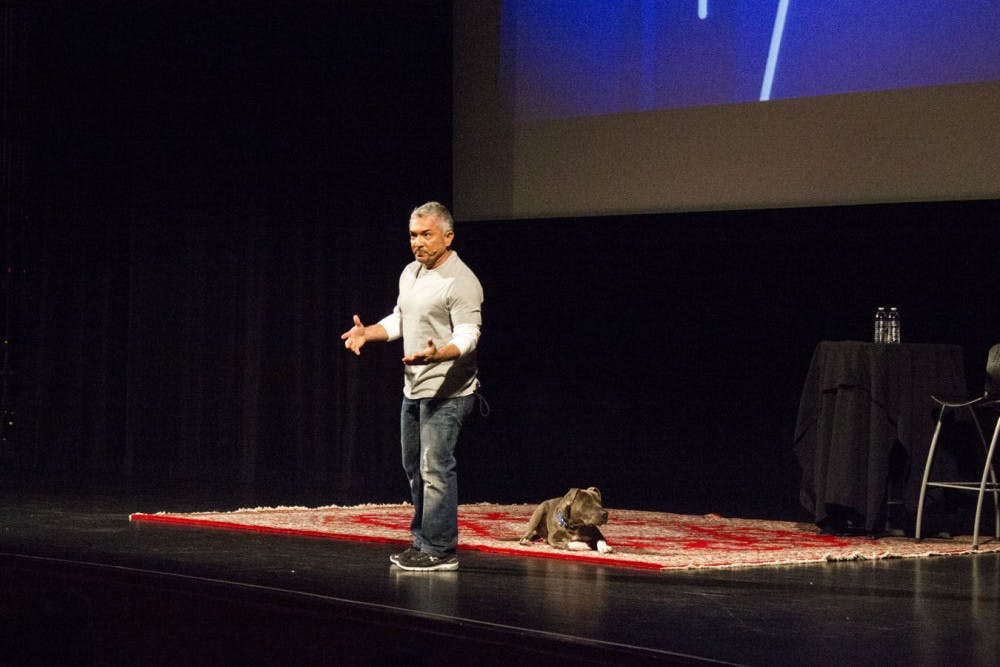Cesar Millan, star of the popular TV show “Dog Whisperer with Cesar Millan,” performed at the H. Ric Luhrs Performing Arts Center at 8 p.m. on Saturday, March 9 and was accompanied by his playful blue pit bull, Junior.
The night began with a video describing his early life, which partly focused on the inspiring role his grandfather played in his life.
During his childhood in rural Culiacán, Mexico, Millan spent most of his time on his grandfather’s farm watching all the dogs running about.
He studied the dogs’ behaviors very closely and was quickly fascinated. After watching shows like “Lassie” and “The Adventures of Rin Tin Tin,” Millan noted that his dream of being the world’s best dog trainer began when he was 13.
When Millan was 21, he crossed the border into California. Millan said he was homeless for a couple of months as he started out in the U.S., but that did not stop him from pursuing his dream.
“If you’re wondering what breed I am, I’m Mexican,” he joked.
After making some money by grooming dogs, Millan was able to move to Los Angeles, where he washed cars for a living. While there, he noticed how detached Americans and their pets were. One main reason for this was because people were humanizing their dogs instead of treating them as pets.
Millan then showed the audience comical photographs of dogs emulating how people look. This made him determined to pursue a job of rehabilitating dogs and training humans.
When he was starting to gain recognition, Oprah Winfrey contacted him and described her issues with her cocker spaniel Sophie. Sophie had a problem of biting other dogs, Millan said.
When he was introduced to Sophie, Winfrey said Sophie was her daughter.
Millan said instead of Sophie’s species being a dog, Winfrey made her species a human. This was a prime example of an owner humanizing his or her dog, which causes the dog to have behavioral problems.
Another tip he gave was to let the dog come to you instead of approaching it first. Running up to a dog instills fear, and the dog needs to learn to trust humans before showing affection.
“This is the best way to meet a dog. Communication begins from a distance,” he said.
When owning and training a dog, he said the most important question to ask yourself is, “How do I feel?”
Millan continued to say that a common problem dogs face is separation anxiety. He showed a video of his dog Junior following him around his home wherever he went. When Millan left his home, Junior cried.
While he was following Millan around the home, he was lying to the dog about what was going on while being in a rush.
Then, he would leave unexpectedly and confuse the dog.
He then showed another video of giving Junior a comfortable place to relax, such as his bed, and Millan acted much calmer. While Millan was doing his daily tasks, Junior stayed on his bed and did not follow him around.
“America doesn’t practice calmness. Dogs mirror that. If you don’t know how you feel, you can buy a heart rate monitor or just look at your dog,” he said.
Toward the end of the show, he brought out a couple of dogs and their owners. The owners explained what the dogs’ problems were, such as over-excitement and anxiety. Millan asked the owners to show the audience how they would normally walk their dogs. Both owners tugged the leash with two hands, causing tension for the dog. This showed how the dog responded to certain types of energy given off by the owner, which can create unwanted behavior.
Millan then took the leashes and exemplified what the owner should do, even when an object such as a dog bowl would distract the dog. When the dogs were with Millan, they were obedient and calm.
“Dogs are not students; they’re our teachers,” he said.
Millan answered questions from audience members who were able to text their questions to a certain number.
When the show ended, Millan said his goal in life is to inspire people, and he ended his set with his favorite quote from Mahatma Gandhi.
“The greatness of a nation and its moral progress can be judged by the way its animals are treated.”
Taylor Caudill is a guest reporter from the Shippensburg Area Senior High School.




The Slate welcomes thoughtful discussion on all of our stories, but please keep comments civil and on-topic. Read our full guidelines here.